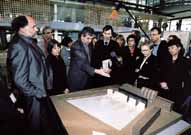
|
|
|

|

|

|

|
|
Click on an image to see a larger, more detailed picture.
|
|
|
|
|
| EPILOGUE: The Aftermath |

|
pg. 667 |

|
|
|
|
| |
 On January 20, 1999, Michael Naumann--German Chancellor Gerhard Schroeder's cultural minister--explains the model of a proposed plan for a Holocaust memorial to be constructed in the heart of Berlin.
On January 20, 1999, Michael Naumann--German Chancellor Gerhard Schroeder's cultural minister--explains the model of a proposed plan for a Holocaust memorial to be constructed in the heart of Berlin.
Photo: Bilderdienst SYddeutscher Verlag / imo
|
 "War of Annihilation: Crimes of the Wehrmacht," a controversial traveling exhibition, shattered the widely held view that the German Army fought nobly during the war and was untainted by Nazi atrocities.
"War of Annihilation: Crimes of the Wehrmacht," a controversial traveling exhibition, shattered the widely held view that the German Army fought nobly during the war and was untainted by Nazi atrocities.
Photo: Reuters/Jochen Eckel/Archive Photos
|
|
The memorial's original design has been scaled down, and the memorial site will be complemented by a Holocaust interpretive center and research library. As the memorial project moved toward implementation in 1999, two other noteworthy items appeared in that spring's German news. Both have at least implicit connections with the Memorial to the Murdered Jews of Europe. First, an Associated Press story--dateline May 22, Cologne, Germany--reported clashes between left- and right-wing political groups. Police kept the adversaries at a distance for a time, but when an estimated 200 supporters of the National Party, a radical rightist faction, began the demonstration that court approval allowed them, about 400 of their left-wing opponents eluded police control and began to pelt the demonstrators with bottles, rocks, eggs, and tomatoes. During the fracas, nearby car and shop windows were smashed, combatants on both sides received minor injuries, and the police took 26 persons into custody. Had the matter amounted to no more than this, international press coverage would have been unlikely, but the reasons behind this German clash were, in fact, newsworthy. Part of Germany's postwar identity has involved the belief that, whatever the evil Hitler and his Nazis did, the Wehrmacht (the World War II-era German Army) had fought with honor that the Holocaust could not besmirch. Many Germans knew better, but impressions about the Army's nobility persisted in the public mind. Then, in March 1995, an exhibition titled Vernichtungskrieg: Verbrechen der Wehrmacht, 1941-1944 (War of Annihilation: Crimes of the Wehrmacht) began to appear in German and Austrian venues. This exhibition of photographs and documents confirmed that the Wehrmacht implemented genocidal policies directed at Jews and Gypsies. The Army also engaged in mass killings of defenseless Slavic people in Poland, Serbia, and the Soviet Union, and it was responsibile for the deaths of more than three million Soviet prisoners of war. This controversial exhibition, viewed by more than 820,000 people in 32 cities as of late spring 1999, provoked considerable dissenting protests. Before the Cologne disturbance clashes between left- and right-wing groups took place in the southwestern German city of Saarbrücken. There, more than 100 leftists, defenders of the exhibit, were arrested when they contested rightist protests against the exhibit's depiction of Wehrmacht atrocities.
|
|

|

|

|

|
 January 1951: Protesters in Jerusalem riot against a West German offer of monetary reparations to Israel and Jews for the Holocaust. Many Israelis don't want to reach an agreement of any kind with Germany; See September 27, 1951.
January 1951: Protesters in Jerusalem riot against a West German offer of monetary reparations to Israel and Jews for the Holocaust. Many Israelis don't want to reach an agreement of any kind with Germany; See September 27, 1951.
|
 January 12, 1951: The United Nations-sponsored Genocide Convention treaty, under terms of Article 56 of the U.N. charter, bans torture, murder, deportation, and persecution of a group for racial, religious, or political reasons.
January 12, 1951: The United Nations-sponsored Genocide Convention treaty, under terms of Article 56 of the U.N. charter, bans torture, murder, deportation, and persecution of a group for racial, religious, or political reasons.
|
 April 12, 1951: A commemorative Yom ha-Sho'ah (Holocaust Day) is enacted into law by Israel's Knesset (parliament).
April 12, 1951: A commemorative Yom ha-Sho'ah (Holocaust Day) is enacted into law by Israel's Knesset (parliament).
|
 June 8, 1951: After being convicted of war crimes, the following former Nazis are hanged at Landsberg Prison: Oswald Pohl, a former SS general in charge of camp works projects and disposition of valuables stolen from inmates; Paul Blobel, former SS-Standartenführer and the head of Sonderkommando 1005; and Otto Ohlendorf, former SS-Gruppenführer and commander of Einsatzgruppe D.
June 8, 1951: After being convicted of war crimes, the following former Nazis are hanged at Landsberg Prison: Oswald Pohl, a former SS general in charge of camp works projects and disposition of valuables stolen from inmates; Paul Blobel, former SS-Standartenführer and the head of Sonderkommando 1005; and Otto Ohlendorf, former SS-Gruppenführer and commander of Einsatzgruppe D.
|
|
|
|
|
| EPILOGUE: The Aftermath |

|
pg. 667 |

|
|
The Holocaust Chronicle
© 2009 Publications International, Ltd.
|
|
